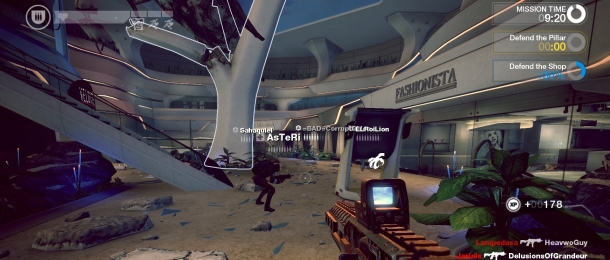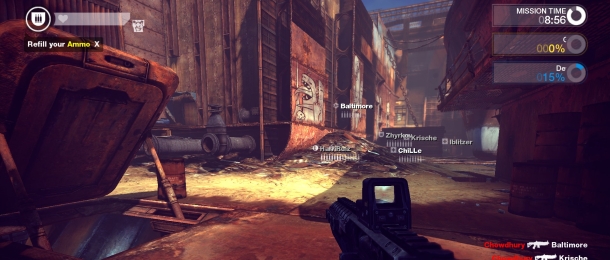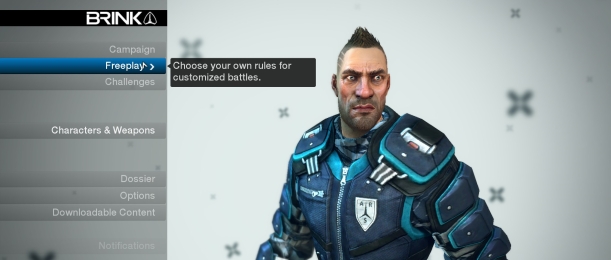
I REALLY WANT to like Brink. After the decent but disappointing Enemy Territory: Quake Wars, I was hoping Brink might be a return to the brilliance of Splash Damage’s Wolfenstein: Enemy Territory. Sadly, from what I’ve seen so far, Brink is more of a great game in theory than in execution.
Instead of WWII or an alien invasion, Brink‘s setting is a futuristic “Ark†– a post-apocalyptic city floating in the middle of the ocean, with two factions (the generic “Security†and “Resistanceâ€) battling for supremacy. Like the previous ET games, each map is a scripted mini-adventure where one team tries to run through a series of objectives (say, breaking into a vault and uploading some data), and the other team tries to stop them. There are four classes – soldier, engineer, medic and operative – each with a few key abilities that can help their team, and you won’t find any jeeps, helicopters or tanks to drive here: Brink‘s combat is all infantry-based.
To ease yourself in, you can play the maps offline in a campaign format using computer-controlled bots. While the bots aren’t totally inept, I lost patience with them quickly, at least as teammates. I’d try to carry a data key from point A to point B and get little support from my team while enemies would pour out of the woodwork four at a time. It wasn’t long before I tired of the bots and went online.
THERE’S A LOT GOING ON in Brink, and the game doesn’t do the greatest job helping you figure it out, especially in terms of objectives. On the PC, it’s easy to miss that the middle mouse button toggles a waypoint towards the current goal (which should arguably be on by default), and for some reason, the text describing on-screen objectives doesn’t change depending on which team you’re on: your HUD will say “Guard the Mainframe†when you’re on offense and actually need to attack it. Oddities like this are common in Brink.
So far, I’ve found Brink‘s eight maps somewhat generic and forgettable. They’re not bad, but feel like pieces of maps you’ve played in a dozen other games: an aquarium, a mall, a reactor, etc. Often, it’s the layout of a map that gives it character, but there’s nothing in Brink that feels as memorable as, say, Wolf:ET‘s gold heist or train maps.

Visually, it’s easy to see that Brink was made by the same team behind Quake Wars, trading grays and greens for reds and blues. Both games were built using id tech, and many of Brink‘s environments and textures have a gritty, unattractive look to them. The one interesting part of the graphics are the player models, which have a stylized, cartoonish look, but still suffer from an ugly grainyness.
THE BIGGEST ADDITION to Brink from previous Enemy Territory games is an experience system with unlockable weapons and abilities, not unlike the most recent Call of Duty games. In Brink, you can gain XP up to level 20, and while the system isn’t as deep as CoD‘s, there’s a fair amount of juggling you can do with weapons and attachments. There’s also a decent amount of leeway to play with your character’s appearance, with various body types, hairstyles, tattoos, gear, and color choices. It’s easy to get sidetracked futzing with your character’s look every time you unlock something.
I’m still on the fence as to whether I like Brink‘s combat model or not. Despite having so many weapons to choose from – mostly automatic rifles – I’ve yet to find one I really like. Most of the weapons feel a little weak to me, but on the plus side, the game doesn’t seem to be a sniper-fest — at least not yet. My biggest complaint with Quake Wars was that you’d often spend a minute running from your spawn point to an objective, only to get one-shotted by someone halfway across the map, and that doesn’t seem like it’ll be a problem with Brink‘s cozier maps.
There’s a parkour system at work in Brink, where you can execute running slides and mantle over obstacles with little effort. If you’re using the light body type, you can also ping-pong off walls and reach higher areas, at the expense of some survivability. I’ve yet to see much of this in actual games, but I suspect that will change as players get more experienced.

Maybe the most disappointing thing about Brink so far is how buggy and unpolished it feels. There were huge lag issues upon the game’s release, and after a quick patch, a new batch of problems cropped up: Sound often cuts out during online games. Onscreen text shows up as corrupted gibberish. I had one match where the entire enemy team was invisible. The PC server browser feels like it was thrown together at the last minute, and simply connecting to a game often requires 4 or 5 attempts. Even the in-game menus don’t seem that well thought-out: online play, arguably the main thing people will be doing every time they fire up the game, is buried under a “Freeplay†option, whatever that means.
I’ve seen people suggest Brink gets better the more you play it, which would make sense as you learn the maps and figure out the game’s various tricks. But I also worry that a few months from now, Brink may venture down the same path as Team Fortress 2, where there’s so much to learn that it creates a massive gulf between good players and novices, turning it into a game of haves and have-nots. Whatever the case, Brink as it exists today isn’t a bad game, just a sloppy one that feels like a missed opportunity. B-
Brink: Enemy Territory Remixed
I REALLY WANT to like Brink. After the decent but disappointing Enemy Territory: Quake Wars, I was hoping Brink might be a return to the brilliance of Splash Damage’s Wolfenstein: Enemy Territory. Sadly, from what I’ve seen so far, Brink is more of a great game in theory than in execution.
Instead of WWII or an alien invasion, Brink‘s setting is a futuristic “Ark†– a post-apocalyptic city floating in the middle of the ocean, with two factions (the generic “Security†and “Resistanceâ€) battling for supremacy. Like the previous ET games, each map is a scripted mini-adventure where one team tries to run through a series of objectives (say, breaking into a vault and uploading some data), and the other team tries to stop them. There are four classes – soldier, engineer, medic and operative – each with a few key abilities that can help their team, and you won’t find any jeeps, helicopters or tanks to drive here: Brink‘s combat is all infantry-based.
To ease yourself in, you can play the maps offline in a campaign format using computer-controlled bots. While the bots aren’t totally inept, I lost patience with them quickly, at least as teammates. I’d try to carry a data key from point A to point B and get little support from my team while enemies would pour out of the woodwork four at a time. It wasn’t long before I tired of the bots and went online.
THERE’S A LOT GOING ON in Brink, and the game doesn’t do the greatest job helping you figure it out, especially in terms of objectives. On the PC, it’s easy to miss that the middle mouse button toggles a waypoint towards the current goal (which should arguably be on by default), and for some reason, the text describing on-screen objectives doesn’t change depending on which team you’re on: your HUD will say “Guard the Mainframe†when you’re on offense and actually need to attack it. Oddities like this are common in Brink.
So far, I’ve found Brink‘s eight maps somewhat generic and forgettable. They’re not bad, but feel like pieces of maps you’ve played in a dozen other games: an aquarium, a mall, a reactor, etc. Often, it’s the layout of a map that gives it character, but there’s nothing in Brink that feels as memorable as, say, Wolf:ET‘s gold heist or train maps.
Visually, it’s easy to see that Brink was made by the same team behind Quake Wars, trading grays and greens for reds and blues. Both games were built using id tech, and many of Brink‘s environments and textures have a gritty, unattractive look to them. The one interesting part of the graphics are the player models, which have a stylized, cartoonish look, but still suffer from an ugly grainyness.
THE BIGGEST ADDITION to Brink from previous Enemy Territory games is an experience system with unlockable weapons and abilities, not unlike the most recent Call of Duty games. In Brink, you can gain XP up to level 20, and while the system isn’t as deep as CoD‘s, there’s a fair amount of juggling you can do with weapons and attachments. There’s also a decent amount of leeway to play with your character’s appearance, with various body types, hairstyles, tattoos, gear, and color choices. It’s easy to get sidetracked futzing with your character’s look every time you unlock something.
I’m still on the fence as to whether I like Brink‘s combat model or not. Despite having so many weapons to choose from – mostly automatic rifles – I’ve yet to find one I really like. Most of the weapons feel a little weak to me, but on the plus side, the game doesn’t seem to be a sniper-fest — at least not yet. My biggest complaint with Quake Wars was that you’d often spend a minute running from your spawn point to an objective, only to get one-shotted by someone halfway across the map, and that doesn’t seem like it’ll be a problem with Brink‘s cozier maps.
There’s a parkour system at work in Brink, where you can execute running slides and mantle over obstacles with little effort. If you’re using the light body type, you can also ping-pong off walls and reach higher areas, at the expense of some survivability. I’ve yet to see much of this in actual games, but I suspect that will change as players get more experienced.
Maybe the most disappointing thing about Brink so far is how buggy and unpolished it feels. There were huge lag issues upon the game’s release, and after a quick patch, a new batch of problems cropped up: Sound often cuts out during online games. Onscreen text shows up as corrupted gibberish. I had one match where the entire enemy team was invisible. The PC server browser feels like it was thrown together at the last minute, and simply connecting to a game often requires 4 or 5 attempts. Even the in-game menus don’t seem that well thought-out: online play, arguably the main thing people will be doing every time they fire up the game, is buried under a “Freeplay†option, whatever that means.
I’ve seen people suggest Brink gets better the more you play it, which would make sense as you learn the maps and figure out the game’s various tricks. But I also worry that a few months from now, Brink may venture down the same path as Team Fortress 2, where there’s so much to learn that it creates a massive gulf between good players and novices, turning it into a game of haves and have-nots. Whatever the case, Brink as it exists today isn’t a bad game, just a sloppy one that feels like a missed opportunity. B-